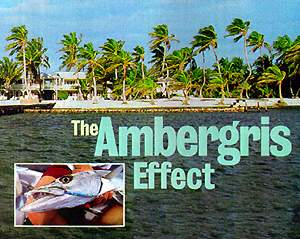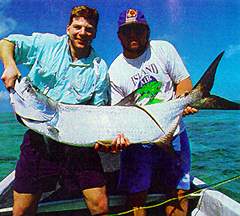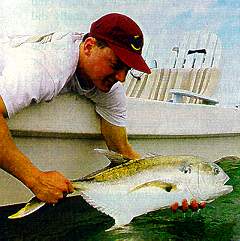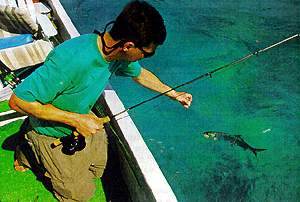WORLD'S GREATEST FISHING VACATIONS, January 4, 2000 By Tom Richardson Sample year-round flats fishing for tarpon, bonefish, and a host of other species at this friendly island off the coast of Belize.
Mario Graniel nosed the skiff into the gritty sand of the shoreline and ordered us to stand. He pointed across an uninviting expanse of dry brush and small, spiky palms that covered the western edge of Ambergris Caye. Our guide's instructions were explicit: "Walk a hundred yards dat way, den go right at de dead. white tree until you hit de shore. Go 'roun til you come to a lagoon wid a big mangrove island in de middle. Bonefish be right in front, mon."
I scanned the horizon for a dead tree. I didn't see one. Matt and I stepped out of the boat with our fly rods and began to make our way across the moonscape of gray limestone. We fought through the tangled brush, rods held above our heads like guerilla fly fishermen. The cobwebs of possibly dangerous spiders clung to our faces. "Did Mario say to go right at the dead tree?" I asked, looking around for snakes. Just then a gray, wrinkled creature the size of a daschund burst from the bushes. It raced across our path with a horrible crabbling of claws and slithered down a hole in the limestone. "What the hell was that?" Matt cried. "I think it was an iguana." "I think it was a dinosaur! " he shouted. "Where are we?"
Over the previous week we had learned that Mario was fond of sending us off on adventures like this, but he had evidently saved the best for last. Had he been training us, I wondered, building our stamina for the ultimate in extreme bonefishing? We crashed on through the undergrowth and eventually emerged on the bank of a shallow lagoon. A large mangrove island squatted in the center.
"Well, this looks like the place," I said. Matt nodded soberly and stepped forward into the ooze grimacing as he sunk up to his knees. It had been a long day, and we were not exactly thrilled about slogging through more of this muck. But there were bonefish here, or so Mario had said, and we'd wade through just about any kind of goo to catch bonefish. I made my way slowly towards the island, the soupy sediment threatening to suck the sneakers off my feet with every step. The viscid grit that had collected beneath my soles had long since hardened into what felt like concrete golf balls, but I pushed on. I hadn't gone more than 30 yards when I came upon a flotilla of translucent tails tacking towards me in the afternoon sun. Right again, Mario! It was an unusual ending to our tarpon trip. After all, tarpon were the main reason Matt and I had come to this little island off the coast of northeastern Belize. We had heard that Ambergris was one of the only places where you can find tarpon on the flats throughout the year, and January seemed like a good time to check it out.
What promise our first morning held! Blue skies and light wind from the southeast, perfect conditions for fishing the flats in back of the island. After a 15-minute run through the mangroves we were there, the flat spreading out before us in a patchwork of turtle grass and white holes covered by three to five feet of emerald water. We scanned the shallows greedily for movement, our gaze hesitating on any dark patch of coral or sunken log. Then we drifted farther down the flat and smack into a gang of tarpon hovering over a bright expanse of sand.
There was no question what species they were, for Matt's long legs had begun to tremble uncontrollably on the casting platform. Summoning his willpower, he made a beautiful cast ahead of the school. One of the fish moved up, stopped behind the fly, and inhaled it in a delicate unhinging of the jaw. Then it jumped and promptly spit the hook. Unfazed, Mario began to pole again, and we soon encountered more fish cruising over the white sand holes that dotted the grass flats. It wasn't long before I hooked a fish, but it broke my tippet on its first jump. Mario stepped down and examined my leader, frown& at the complicated series of Bimini twists and Huffnagle knots. "You want to screw around or you want to catch a fish?" he asked seriously. He took some 80-pound test, tied it to some 60-pound, then tied that to a piece of 100-pound shock tippet. So much for the long nights of tying tarpon leaders.
By late morning the flat had really come alive. Jacks were tearing through baitfish, rays were vacuuming the bottom, and a school of small permit even cruised by. We were seeing lots of tarpon, and Matt had jumped another fish. -Then, just before noon, we poled close to a deep depression in the bottom, an inviting blue hole scooped out of the flat. 'Sea cows make those," Mario explained. "Sometimes they'll spend a week in one."
The hole held no manatees on this day, but it did contain tarpon. We could see several of them lined up along the grassy edge. I singled out a fish and cast to it, stripping my fly into the open. The tarpon merely looked at the fly and turned away. "Wait, wait," Mario hissed as I started to pick up the line. "There's another one coming. Keep stripping." A silver shape suddenly darted in from the side and slashed at the fly. I kept stripping and the fish spun around and charged again, missing a second time. The fly was just ten feet from the boat when the tarpon made a final pass and turned with the fly in its mouth. I felt the line tighten and begin to slide through my fingers. Then I caught a glimpse of something truly frightening. A large tangled ball of line was levitating off the deck at my feet, like a snake preparing to strike. I closed my eyes and waited for the guides to be ripped from the rod. But then, a miracle! The fish jumped just as the tangle reached the first guide, and somehow the line ball got smaller and smaller until it finally shrunk itself down to a tiny loop. I felt it happily bumping its way along the length of the rod and soon the little loop was dangling above the water, making for the horizon. The fish jumped and jumped but the hook was firmly embedded in the roof of its mouth. After 40 minutes I had it alongside the skiff, where Mario estimated its weight at 60 pounds. Why does it always seem like the best weather occurs at the beginning of a fishing trip? In my experience, things usually deteriorate just as I'm getting my feel for a new place, which is exactly what happened this time. The next two days were windy and overcast, courtesy of a nasty cold front that rolled through town. When the sun finally did reappear, the flats were too roiled to fish.
If cloud cover makes it difficult to spot the tarpon, there arc other options. In our case, we tried to make the best of it by blind-casting with plugs and drifting live sardines over the flats. The latter can be a very effective way to catch tarpon on cloudy days, although you stand a good chance of hooking rays or getting bitten off by sharks and barracuda. If the tarpon action is a bust, there are other exciting species to tangle with, such as jack crevalle. These powerful fish weigh from ten to 25 pounds, and can usually be seen chasing bait somewhere on the flats. Tossing a lure, bait, or a fly into the school usually guarantees a hook-up. Barracuda also live on the flats, and we caught lots of them on small silver spoons, five-inch streamer flies, and epoxy flies. Mario told us that the best time for 'cuda was in June, when the big reef fish migrated inshore to spawn. On the other side of Ambergris, the ocean side, you'll find more options. Inside the barrier reef are snapper in the ten-pound range, ladyfish, and more barracuda. When weather and seas allow, you can also fish the deep ocean waters beyond the reef for sailfish, wahoo, dolphin, tuna, cubera snapper, and king mackerel, or deep-drop for big grouper and snapper. The best fishing for pelagic species usually occurs in April and May. But what about the bonefish? I must say that we hadn't heard many rave reviews about the bonefishing at Ambergris, so we were pleasantly surprised by what we found. The bones aren't big - one to five pounds - but they can sure save the day if sight-fishing is your game. We caught our first bones from the skiff, but after that we fished on foot. I won't say that slogging through the soft sediment of the lagoons is easy work, but it's the best strategy since the fish are usually feeding in extremely shallow water. Tailing fish are common (great on cloudy days), and for these you'll need small, unweighted flies. Overall, we felt that Ambergris proved its reputation as a tarpon hot spot, even though our fishing was limited because of the weather. It's clear that you can get lots of shots when conditions are right. In the meantime, you can rest assured that there are plenty of other species to keep you busy if the weather takes a turn for the worse.
Box lunches and drinks are waiting for you before you head out in the morning, and there is plenty of time for showering, cleaning your equipment, and relaxing before dinner is served. Meals at the lodge are superb, and include lots of fresh fish, chicken, and meat dishes. If you want a little change of scenery you can take a water taxi into the nearby town of San Pedro and check out the restaurants, shops, and bars.
Guides |

|





 Like any flats destination, wind and clouds can affect the sight-casting action at Ambergris. When it blows hard for several days, the shallows can get stirred up pretty badly, although the water usually clears within 12 to 24 hours. Therefore, it's always best to stay for at least five days to hedge your bets.
Like any flats destination, wind and clouds can affect the sight-casting action at Ambergris. When it blows hard for several days, the shallows can get stirred up pretty badly, although the water usually clears within 12 to 24 hours. Therefore, it's always best to stay for at least five days to hedge your bets.